Complete Health Indicator Report of Child sexual abuse, self-reported
Definition
Self-reported child sexual abuse data is retrospective data collected from adults via three questions in the Utah BRFSS Adverse Childhood Experiences (ACEs) Module and youth via the Utah YRBS tier 2 ACEs and Positive Childhood Experiences (PCEs) questionnaire. Adult prevalence is looking retrospectively at their whole childhood (<18), while youth prevalence only looks back at the previous 12 months.Numerator
The number of youth or adults who indicated at least one instance of sexual abuse on the YRBS (2021) or BRFSS (2013, 2016, 2018, 2020).Denominator
The total number of youth or adults who provided any response to the sexual abuse question/s on the YRBS (2021) or BRFSS (2013, 2016, 2018, 2020).Data Interpretation Issues
BRFSS (Adults) 1. How often did anyone at least 5 years older than you or an adult, ever touch you sexually? Would you say? 2. How often did anyone at least 5 years older than you or an adult, try to make you touch them sexually? Would you say? 3. How often did anyone at least 5 years older than you or an adult, force you to have sex? Would you say? (Possible answers: Never, Once, More than once; questions refer to the time period before the respondent was 18 years of age) YRBS (Youth) During the past 12 months, how many times did anyone force you to do sexual things that you did not want to do? (Count such things as kissing, touching, or being physically forced to have sexual intercourse.) (Possible answers: 0, 1, 2 or 3, 4 or 5, or 6+) Response options from both surveys were dichotomized into whether or not sexual abuse occurred at all. The responses are subjective, however, the subjective reality is what seems to matter when considering the potential for long-term negative impacts.Why Is This Important?
All types of child abuse represent a threat to public health. Child sexual abuse is one of eight commonly tracked adverse childhood experiences (ACEs) and research into child abuse and neglect (CAN) and ACEs has consistently shown the potential for many negative long-term impacts on health, opportunity, and well-being. Tracking child abuse prevalence is a complicated task and some of the best data available are self-reported retrospective data which gives a more complete view of prevalence over child protective services or hospital data.Healthy People Objective IVP-38:
Reduce nonfatal child maltreatmentU.S. Target: 8.5 maltreatment victims per 1,000 children
How Do We Compare With the U.S.?
When comparing BRFSS data, the prevalence of sexual child abuse in Utah is higher than nationally (13.9% or ~1 in 7 vs 11.6% or ~1 in 9). National prevalence comes from a 2018 Merrick, et al. study that included 2011-2014 BRFSS data from 23 states, while Utah prevalence is from the ACEs Module included in the Utah BRFSS in 2013, 2016, 2018, and 2020. Source: Merrick, M.T., Ford, D.C., Ports, K. A., Guinn, A. S. (2018). Prevalence of Adverse Childhood Experiences From the 2011-2014 Behavioral Risk Factor Surveillance System in 23 States. JAMA Pediatrics, 172(11), 1038-1044.Evidence-based Practices
Promote safe stable nurturing relationships and environments for all children by: *Strengthen economic support for families *Strengthen social norms to connect with and support parents and youth *Enhance parenting skills to promote healthy child development *Promote quality care and education early in life *Intervene to lessen harm and prevent future riskGraphical Data Views
Self-reported child sexual abuse prevalence (YRBS/youth and BRFSS/adults) by sex and data source, Utah, 2021 (YRBS) and 2013, 2016, 2018, 2020 (BRFSS)
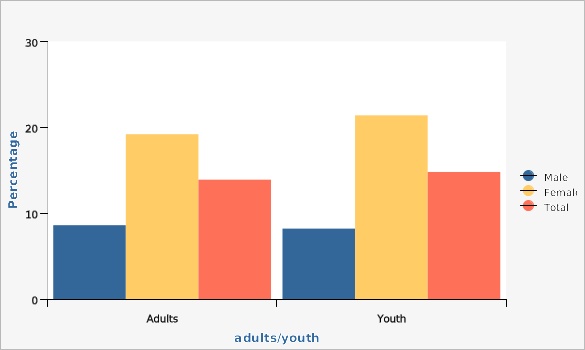
Female adults indicated a significantly higher prevalence of sexual abuse during their childhood than male adults (~1 in 5 vs ~1 in 12). Female youth also indicated a similar significantly higher prevalence of sexual abuse in the last 12 months than male youth (also ~1 in 5 vs ~1 in 12).
| Males vs. Females | adults/youth | Percentage | Lower Limit | Upper Limit | Note | Numer- ator | Denom- inator |
|---|---|---|---|---|---|---|---|
Record Count: 6 | |||||||
| Male | Adults | 8.6 | 8.0 | 9.3 | 935 | ||
| Male | Youth | 8.2 | 6.4 | 10.5 | 699 | ||
| Female | Adults | 19.2 | 18.3 | 20.1 | significantly higher than adult males | 2,347 | |
| Female | Youth | 21.4 | 18.0 | 25.2 | significantly higher than male youth | 761 | |
| Total | Adults | 13.9 | 13.3 | 14.5 | 3,284 | ||
| Total | Youth | 14.8 | 12.8 | 17.2 | 1,471 | ||
Data Notes
Adult/BRFSS and youth/YRBS sexual abuse data are each collected with different questions that include different time frames. The sexual abuse question utilized in the YRBS has only been asked one time in 2021, while the BRFSS question has been asked in 2013, 2016, 2018, and 2020.Self-reported child sexual abuse prevalence (YRBS/youth and BRFSS/adults) by grade/age-group, Utah, 2021 (YRBS) and 2013, 2016, 2018, 2020 (BRFSS)

11th-grade youth respondents indicated the highest prevalence of sexual abuse in the last 12 months, significantly higher than the overall youth prevalence (~1 in 5 vs ~1 in 7). Adults 35-49 and 50-64 indicated a significantly higher prevalence of sexual abuse during their childhood than the overall state adult prevalence (~1 in 6 vs ~1 in 7) and adults 18-34 and 65+ indicated a significantly lower prevalence of sexual abuse than the overall state adult prevalence (~1 in 8 and 1 in 9 vs ~1 in 7).
| Percentage | Lower Limit | Upper Limit | Note | Numer- ator | Denom- inator | |
|---|---|---|---|---|---|---|
Record Count: 8 | ||||||
| 9th graders | 11.2 | 7.6 | 16.2 | 480 | ||
| 10th graders | 16.5 | 12.8 | 21.0 | 474 | ||
| 11th graders | 19.0 | 14.7 | 24.2 | 302 | ||
| 12th graders | 13.3 | 7.9 | 21.5 | 201 | ||
| Ages 18-34 | 11.9 | 10.9 | 13.0 | significantly lower than the state prevalence | 672 | |
| Ages 35-49 | 15.8 | 14.7 | 17.1 | significantly higher than the state prevalence | 927 | |
| Ages 50-64 | 15.9 | 14.7 | 17.2 | significantly higher than the state prevalence | 933 | |
| Ages 65+ | 11.4 | 10.4 | 12.5 | significantly lower than the state prevalence | 752 | |
Data Notes
Adult/BRFSS and youth/YRBS sexual abuse data are each collected with different questions that include different time frames. The sexual abuse question utilized in the YRBS has only been asked one time in 2021, while the BRFSS question has been asked in 2013, 2016, 2018, and 2020.Self-reported child sexual abuse prevalence (BRFSS, age-adjusted) by race/ethnicity, Utah, 2013, 2016, 2018, 2020
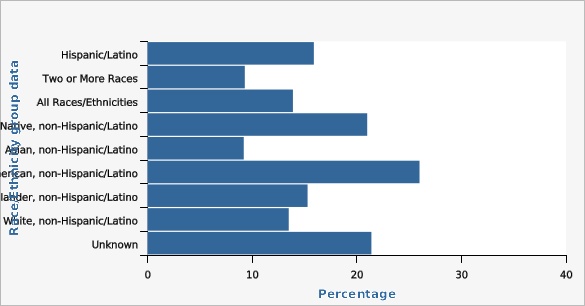
Adults who indicated Black/African American (Non-Hispanic), Unknown, or American Indian/Alaska Native (non-Hispanic) had a significantly higher prevalence of sexual abuse during their childhood than all races and ethnicities together (~1 in 4 and 1 in 5 vs ~1 in 7).
| Race/Ethnicity group data | Percentage | Lower Limit | Upper Limit | Note | Numer- ator | |
|---|---|---|---|---|---|---|
Record Count: 9 | ||||||
| Hispanic/Latino | 15.9 | 13.8 | 18.2 | 279 | ||
| Two or More Races | 9.3 | 5.6 | 15.0 | 25 | ||
| All Races/Ethnicities | 13.9 | 13.3 | 14.5 | 3,284 | ||
| American Indian/Alaska Native, non-Hispanic/Latino | 21.0 | 14.8 | 28.9 | significantly higher than the state prevalence | 48 | |
| Asian, non-Hispanic/Latino | 9.2 | 5.4 | 15.3 | 21 | ||
| Black/African American, non-Hispanic/Latino | 26.0 | 17.1 | 37.6 | significantly higher than the state prevalence | 32 | |
| Native Hawaiian/Pacific Islander, non-Hispanic/Latino | 15.3 | 8.2 | 26.9 | 14 | ||
| White, non-Hispanic/Latino | 13.5 | 12.9 | 14.2 | 2,833 | ||
| Unknown | 21.4 | 14.1 | 31.3 | significantly higher than the state prevalence | 32 | |
Data Notes
Analysis by race and ethnicity only utilizes age-adjusted adult data collected in the 2013, 2016, 2018, and 2020 BRFSS and not youth/YRBS data.Self-reported child sexual abuse prevalence (BRFSS, age-adjusted) by sexual orientation, Utah, 2013, 2016, 2018, 2020
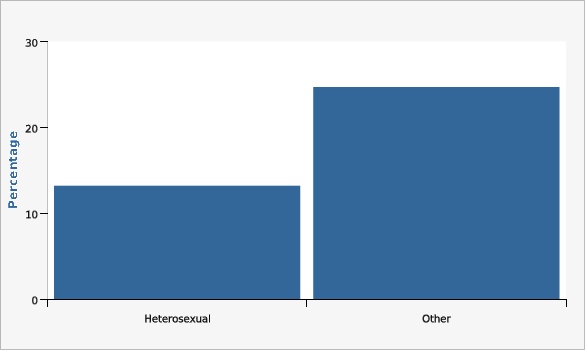
Adults who indicated a sexual orientation other than heterosexual (homosexual, bisexual, or other) had a significantly higher prevalence of sexual abuse during their childhood than the overall state prevalence (~1 in 4 vs ~1 in 8).
| Percentage | Lower Limit | Upper Limit | Note | Numer- ator | ||
|---|---|---|---|---|---|---|
Record Count: 2 | ||||||
| Heterosexual | 13.2 | 12.6 | 13.8 | significantly lower than the state prevalence | 2,942 | |
| Other | 24.7 | 21.4 | 28.3 | significantly higher than the state prevalence | 295 | |
Data Notes
Analysis by sexual orientation only utilizes age-adjusted adult data collected in the 2013, 2016, 2018, and 2020 BRFSS and not youth/YRBS data.Self-reported child sexual abuse prevalence (BRFSS, age-adjusted) by disability type, Utah, 2013, 2016, 2018, 2020

Adults who indicated any type of disability (cognitive, mobility, self-care, independent living, difficulty seeing/blind, or difficulty hearing/deaf) all had a significantly higher prevalence of sexual abuse during their childhood than the overall state prevalence and than adults with no disability (~1 in 3-4 vs ~1 in 8).
| Disability Type | Percentage | Lower Limit | Upper Limit | Note | Numer- ator | |
|---|---|---|---|---|---|---|
Record Count: 7 | ||||||
| Cognitive disability | 29.5 | 27.0 | 32.0 | significantly higher than the state prevalence | 682 | |
| Mobility disability | 29.7 | 26.0 | 33.7 | significantly higher than the state prevalence | 582 | |
| Self-care disability | 36.3 | 29.5 | 43.7 | significantly higher than the state prevalence | 176 | |
| Independent living disability | 33.3 | 29.6 | 37.2 | significantly higher than the state prevalence | 381 | |
| Difficulty seeing or blind | 24.3 | 19.9 | 29.3 | significantly higher than the state prevalence | 183 | |
| Difficulty hearing or deaf | 25.4 | 20.2 | 31.4 | significantly higher than the state prevalence | 216 | |
| No disability | 12.2 | 11.5 | 12.9 | significantly lower than the state prevalence | 1,649 | |
Data Notes
Analysis by disability type only utilizes age-adjusted adult data collected in the 2013, 2016, 2018, and 2020 BRFSS and not youth/YRBS data.Self-reported child sexual abuse prevalence (BRFSS, age-adjusted) by education, Utah, 2013, 2016, 2018, 2020
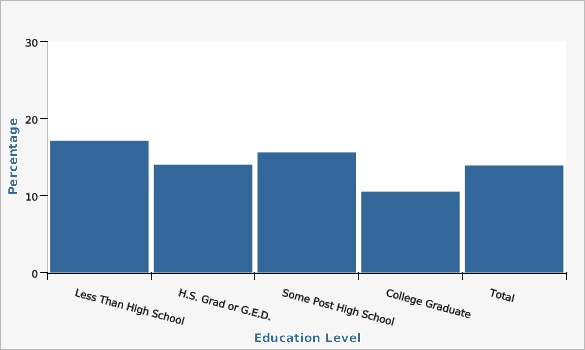
Adults with an education level less than a high school or some post high school indicated a significantly higher prevalence of sexual abuse during their childhood than the overall state adult prevalence (~1 in 6 vs ~1 in 7), while adult college graduates indicated a significantly lower prevalence than the overall state prevalence (~1 in 10 vs ~1 in 7).
| Education Level | Percentage | Lower Limit | Upper Limit | Note | Numer- ator | |
|---|---|---|---|---|---|---|
Record Count: 5 | ||||||
| Less Than High School | 17.1 | 14.4 | 20.2 | significantly higher than the state prevalence | 169 | |
| H.S. Grad or G.E.D. | 14.0 | 12.9 | 15.2 | 820 | ||
| Some Post High School | 15.6 | 14.6 | 16.7 | significantly higher than the state prevalence | 1,232 | |
| College Graduate | 10.5 | 9.7 | 11.4 | significantly lower than the state prevalence | 1,059 | |
| Total | 13.9 | 13.3 | 14.5 | 3,284 | ||
Data Notes
Analysis by education only utilizes age-adjusted adult data collected in the 2013, 2016, 2018, and 2020 BRFSS and not youth/YRBS data.Self-reported child sexual abuse prevalence (BRFSS, age-adjusted) by income, Utah, 2013, 2016, 2018, 2020
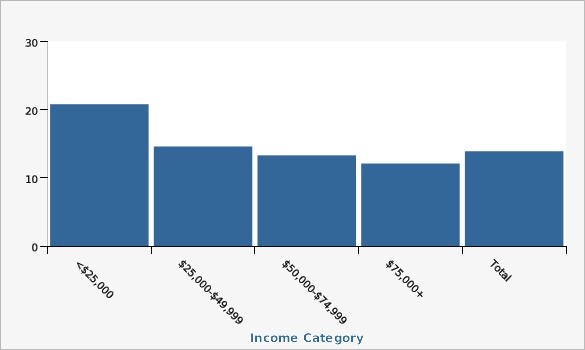
Adults who indicated a household income of <$25,000 a year had a significantly higher prevalence of sexual abuse during their childhood than the overall state prevalence (~1 in 5 vs ~1 in 7), while adults with household incomes of $75,000+ indicated a significantly lower prevalence than the overall state prevalence (~1 in 8 vs ~1 in 7).
| Income Category | Lower Limit | Upper Limit | Note | Numer- ator | ||
|---|---|---|---|---|---|---|
Record Count: 5 | ||||||
| <$25,000 | 20.8 | 18.9 | 22.9 | significantly higher than the state prevalence | 635 | |
| $25,000-$49,999 | 14.6 | 13.2 | 16.0 | 660 | ||
| $50,000-$74,999 | 13.3 | 12.0 | 14.8 | 521 | ||
| $75,000+ | 12.1 | 11.2 | 13.0 | significantly lower than the state prevalence | 1,069 | |
| Total | 13.9 | 13.3 | 14.5 | 3,284 | ||
Data Notes
Analysis by income only utilizes age-adjusted adult data collected in the 2013, 2016, 2018, and 2020 BRFSS and not youth/YRBS data.Self-reported child sexual abuse prevalence (BRFSS, age-adjusted) by local health district, Utah, 2013, 2016, 2018, 2020
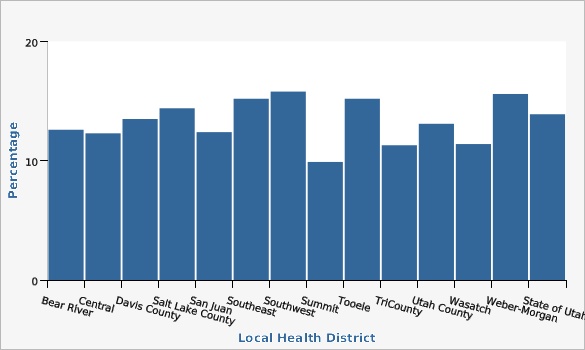
Adults in Summit County and TriCounty had a significantly lower prevalence of sexual abuse during their childhood than the state prevalence (~1 in 10 and 1 in 9 vs ~1 in 7).
| Local Health District | Percentage | Lower Limit | Upper Limit | Note | Numer- ator | |
|---|---|---|---|---|---|---|
Record Count: 14 | ||||||
| Bear River | 12.6 | 10.6 | 14.9 | 180 | ||
| Central | 12.3 | 9.4 | 15.9 | 163 | ||
| Davis County | 13.5 | 11.9 | 15.3 | 307 | ||
| Salt Lake County | 14.4 | 13.4 | 15.5 | 952 | ||
| San Juan | 12.4 | 8.4 | 17.9 | 45 | ||
| Southeast | 15.2 | 11.9 | 19.2 | 126 | ||
| Southwest | 15.8 | 13.6 | 18.4 | 225 | ||
| Summit | 9.9 | 7.3 | 13.5 | significantly lower than the state prevalence | 61 | |
| Tooele | 15.2 | 12.3 | 18.5 | 163 | ||
| TriCounty | 11.3 | 9.4 | 13.6 | significantly lower than the state prevalence | 167 | |
| Utah County | 13.1 | 11.7 | 14.5 | 462 | ||
| Wasatch | 11.4 | 8.6 | 15.0 | 84 | ||
| Weber-Morgan | 15.6 | 13.7 | 17.7 | 322 | ||
| State of Utah | 13.9 | 13.3 | 14.5 | 3,284 | ||
Data Notes
Analysis by geography only utilizes age-adjusted adult data collected in the 2013, 2016, 2018, and 2020 BRFSS and not youth/YRBS data.Self-reported child sexual abuse prevalence (BRFSS, age-adjusted) by small area, Utah, 2013, 2016, 2018, 2020
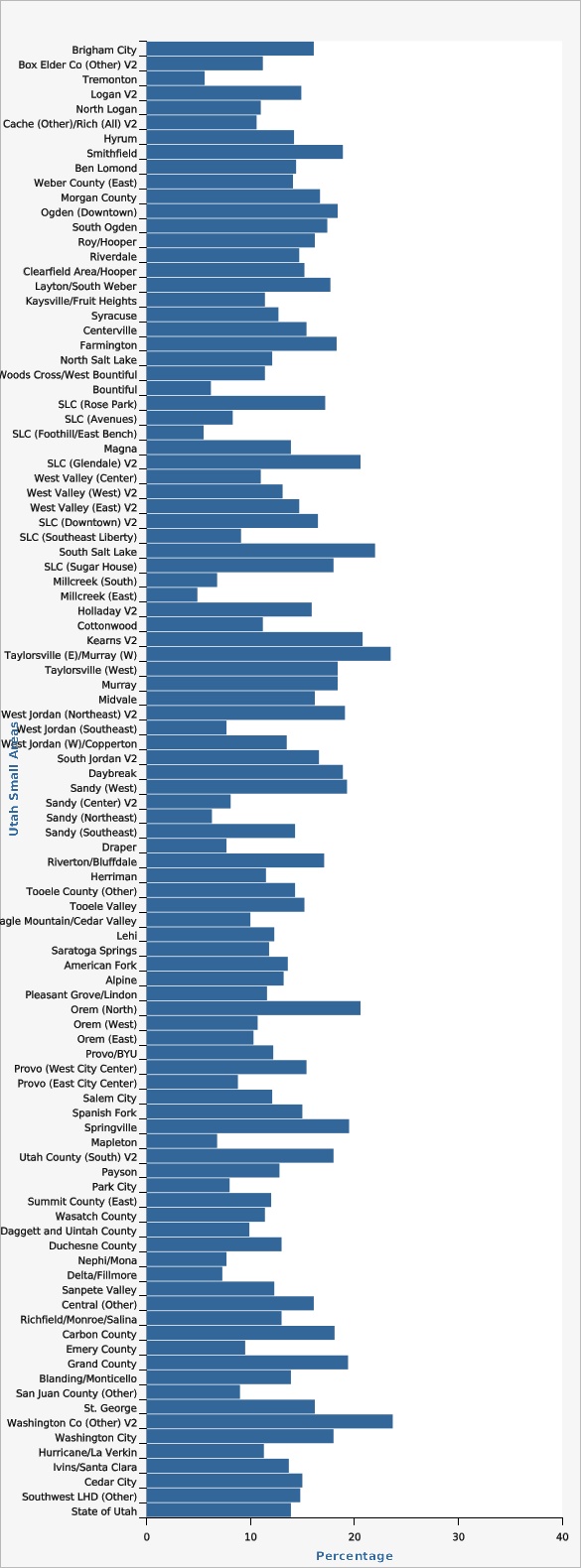
Adults in the Utah Small Areas of Layton/South Weber, South Salt Lake, Kearns V2, Taylorsville (East)/Murray (West), and Orem (North) had a significantly higher prevalence of sexual abuse during their childhood than the overall state prevalence (~1 in 4-6 vs ~1 in 7). Adults in the Utah Small Areas of Tremonton, Bountiful, Salt Lake City (Avenues), Salt Lake City (Foothill/East Bench), Millcreek (South), Millcreek (East), West Jordan (Southeast), Sandy (Center) V2, Draper, Park City, Daggett, and Uintah County, and Delta/Fillmore had a significantly lower prevalence of sexual abuse during their childhood than the overall state prevalence (~1 in 10-20 vs ~1 in 7).
| Utah Small Areas | Percentage | Lower Limit | Upper Limit | Note | Numer- ator | |
|---|---|---|---|---|---|---|
Record Count: 100 | ||||||
| Brigham City | 16.1 | 10.4 | 24.1 | 30 | ||
| Box Elder Co (Other) V2 | 11.2 | 6.4 | 18.7 | 16 | ||
| Tremonton | 5.6 | 2.4 | 12.5 | significantly lower than the state prevalence, *interpret w/caution | 8 | |
| Logan V2 | 14.9 | 11.0 | 20.0 | 54 | ||
| North Logan | 11.0 | 6.3 | 18.5 | 20 | ||
| Cache (Other)/Rich (All) V2 | 10.6 | 6.3 | 17.5 | 24 | ||
| Hyrum | 14.2 | 6.2 | 29.3 | *interpret w/caution | 7 | |
| Smithfield | 18.9 | 11.2 | 30.2 | 16 | ||
| Ben Lomond | 14.4 | 10.8 | 18.9 | 61 | ||
| Weber County (East) | 14.1 | 10.0 | 19.5 | 47 | ||
| Morgan County | 16.7 | 9.3 | 28.2 | 16 | ||
| Ogden (Downtown) | 18.4 | 13.6 | 24.4 | 48 | ||
| South Ogden | 17.4 | 12.7 | 23.4 | 54 | ||
| Roy/Hooper | 16.2 | 12.0 | 21.6 | 55 | ||
| Riverdale | 14.7 | 9.8 | 21.3 | 33 | ||
| Clearfield Area/Hooper | 15.2 | 11.6 | 19.8 | 58 | ||
| Layton/South Weber | 17.7 | 14.3 | 21.7 | significantly higher than the state prevalence | 98 | |
| Kaysville/Fruit Heights | 11.4 | 7.7 | 16.6 | 30 | ||
| Syracuse | 12.7 | 7.9 | 19.9 | 23 | ||
| Centerville | 15.4 | 8.6 | 26.3 | *interpret w/caution | 13 | |
| Farmington | 18.3 | 10.0 | 31.1 | 21 | ||
| North Salt Lake | 12.1 | 6.5 | 21.6 | *interpret w/caution | 11 | |
| Woods Cross/West Bountiful | 11.4 | 6.8 | 18.6 | 15 | ||
| Bountiful | 6.2 | 4.1 | 9.2 | significantly lower than the state prevalence | 31 | |
| SLC (Rose Park) | 17.2 | 10.9 | 26.0 | 25 | ||
| SLC (Avenues) | 8.3 | 5.1 | 13.3 | significantly lower than the state prevalence | 17 | |
| SLC (Foothill/East Bench) | 5.5 | 3.0 | 10.0 | significantly lower than the state prevalence | 14 | |
| Magna | 13.9 | 8.6 | 21.8 | 24 | ||
| SLC (Glendale) V2 | 20.6 | 13.6 | 30.1 | 23 | ||
| West Valley (Center) | 11.0 | 7.6 | 15.7 | 39 | ||
| West Valley (West) V2 | 13.1 | 7.7 | 21.6 | 18 | ||
| West Valley (East) V2 | 14.7 | 10.0 | 21.0 | 39 | ||
| SLC (Downtown) V2 | 16.5 | 11.3 | 23.6 | 32 | ||
| SLC (Southeast Liberty) | 9.1 | 5.3 | 15.1 | 17 | ||
| South Salt Lake | 22.0 | 14.1 | 32.7 | significantly higher than the state prevalence | 29 | |
| SLC (Sugar House) | 18.0 | 12.0 | 26.1 | 37 | ||
| Millcreek (South) | 6.8 | 3.5 | 13.1 | significantly lower than the state prevalence | 14 | |
| Millcreek (East) | 4.9 | 2.1 | 10.7 | significantly lower than the state prevalence, *interpret w/caution | 12 | |
| Holladay V2 | 15.9 | 9.8 | 24.8 | 27 | ||
| Cottonwood | 11.2 | 7.5 | 16.4 | 41 | ||
| Kearns V2 | 20.8 | 14.8 | 28.3 | significantly higher than the state prevalence | 38 | |
| Taylorsville (E)/Murray (W) | 23.5 | 16.9 | 31.7 | significantly higher than the state prevalence | 48 | |
| Taylorsville (West) | 18.4 | 13.3 | 25.0 | 41 | ||
| Murray | 18.4 | 12.6 | 26.2 | 40 | ||
| Midvale | 16.2 | 10.5 | 24.1 | 27 | ||
| West Jordan (Northeast) V2 | 19.1 | 12.7 | 27.5 | 32 | ||
| West Jordan (Southeast) | 7.7 | 4.8 | 12.1 | significantly lower than the state prevalence | 20 | |
| West Jordan (W)/Copperton | 13.5 | 8.8 | 20.3 | 29 | ||
| South Jordan V2 | 16.6 | 11.9 | 22.6 | 40 | ||
| Daybreak | 18.9 | 11.9 | 28.7 | 22 | ||
| Sandy (West) | 19.3 | 13.1 | 27.6 | 34 | ||
| Sandy (Center) V2 | 8.1 | 4.8 | 13.4 | significantly lower than the state prevalence | 19 | |
| Sandy (Northeast) | 6.3 | 2.2 | 16.7 | *interpret w/caution | 7 | |
| Sandy (Southeast) | 14.3 | 9.2 | 21.4 | 25 | ||
| Draper | 7.7 | 4.7 | 12.5 | significantly lower than the state prevalence | 22 | |
| Riverton/Bluffdale | 17.1 | 11.9 | 23.9 | 38 | ||
| Herriman | 11.5 | 7.6 | 17.0 | 31 | ||
| Tooele County (Other) | 14.3 | 9.2 | 21.6 | 37 | ||
| Tooele Valley | 15.2 | 12.1 | 18.9 | 124 | ||
| Eagle Mountain/Cedar Valley | 10.0 | 5.1 | 18.8 | *interpret w/caution | 11 | |
| Lehi | 12.3 | 8.7 | 17.0 | 45 | ||
| Saratoga Springs | 11.8 | 6.6 | 20.0 | 17 | ||
| American Fork | 13.6 | 9.3 | 19.4 | 37 | ||
| Alpine | 13.2 | 5.8 | 27.3 | *interpret w/caution | 9 | |
| Pleasant Grove/Lindon | 11.6 | 8.0 | 16.5 | 42 | ||
| Orem (North) | 20.6 | 14.9 | 27.9 | significantly higher than the state prevalence | 39 | |
| Orem (West) | 10.7 | 6.5 | 17.1 | 25 | ||
| Orem (East) | 10.3 | 5.6 | 18.3 | *interpret w/caution | 20 | |
| Provo/BYU | 12.2 | 7.8 | 18.6 | 27 | ||
| Provo (West City Center) | 15.4 | 9.9 | 23.2 | 27 | ||
| Provo (East City Center) | 8.8 | 4.4 | 16.7 | 14 | ||
| Salem City | 12.1 | 5.9 | 23.5 | *interpret w/caution | 7 | |
| Spanish Fork | 15.0 | 10.1 | 21.8 | 34 | ||
| Springville | 19.5 | 13.9 | 26.6 | 45 | ||
| Mapleton | 6.8 | 2.5 | 17.0 | *interpret w/caution | 6 | |
| Utah County (South) V2 | 18.0 | 10.1 | 29.8 | *interpret w/caution | 13 | |
| Payson | 12.8 | 8.4 | 18.9 | 28 | ||
| Park City | 8.0 | 5.1 | 12.3 | significantly lower than the state prevalence | 29 | |
| Summit County (East) | 12.0 | 7.8 | 18.0 | 30 | ||
| Wasatch County | 11.4 | 8.6 | 15.0 | 84 | ||
| Daggett and Uintah County | 9.9 | 7.7 | 12.6 | significantly lower than the state prevalence | 95 | |
| Duchesne County | 13.0 | 9.9 | 17.0 | 72 | ||
| Nephi/Mona | 7.7 | 3.9 | 14.7 | *interpret w/caution | 11 | |
| Delta/Fillmore | 7.3 | 4.3 | 12.4 | significantly lower than the state prevalence | 20 | |
| Sanpete Valley | 12.3 | 8.2 | 17.9 | 42 | ||
| Central (Other) | 16.1 | 10.1 | 24.6 | 55 | ||
| Richfield/Monroe/Salina | 13.0 | 8.6 | 19.3 | 32 | ||
| Carbon County | 18.1 | 13.1 | 24.6 | 73 | ||
| Emery County | 9.5 | 5.8 | 15.1 | 26 | ||
| Grand County | 19.4 | 11.4 | 31.0 | 27 | ||
| Blanding/Monticello | 13.9 | 9.2 | 20.7 | 30 | ||
| San Juan County (Other) | 9.0 | 4.0 | 18.9 | *interpret w/caution | 15 | |
| St. George | 16.2 | 12.4 | 20.9 | 74 | ||
| Washington Co (Other) V2 | 23.7 | 13.4 | 28.5 | *interpret w/caution | 13 | |
| Washington City | 18.0 | 11.4 | 27.1 | 24 | ||
| Hurricane/La Verkin | 11.3 | 7.2 | 17.5 | 22 | ||
| Ivins/Santa Clara | 13.7 | 8.0 | 22.6 | 14 | ||
| Cedar City | 15.0 | 10.5 | 21.1 | 36 | ||
| Southwest LHD (Other) | 14.8 | 9.8 | 21.8 | 35 | ||
| State of Utah | 13.9 | 13.3 | 14.5 | 3,284 | ||
Data Notes
Analysis by geography only utilizes age-adjusted adult data collected in the 2013, 2016, 2018, and 2020 BRFSS and not youth/YRBS data.More Resources and Links
Evidence-based community health improvement ideas and interventions may be found at the following sites:- Centers for Disease Control and Prevention (CDC) WONDER Database, a system for disseminating public health data and information.
- United States Census Bureau data dashboard.
- Utah healthy Places Index, evidence-based and peer-reviewed tool, supports efforts to prioritize equitable community investments, develop critical programs and policies across the state, and much more.
- County Health Rankings
- Kaiser Family Foundation's StateHealthFacts.org
- Medical literature can be queried at PubMed library.
Page Content Updated On 10/07/2022,
Published on 06/21/2023
